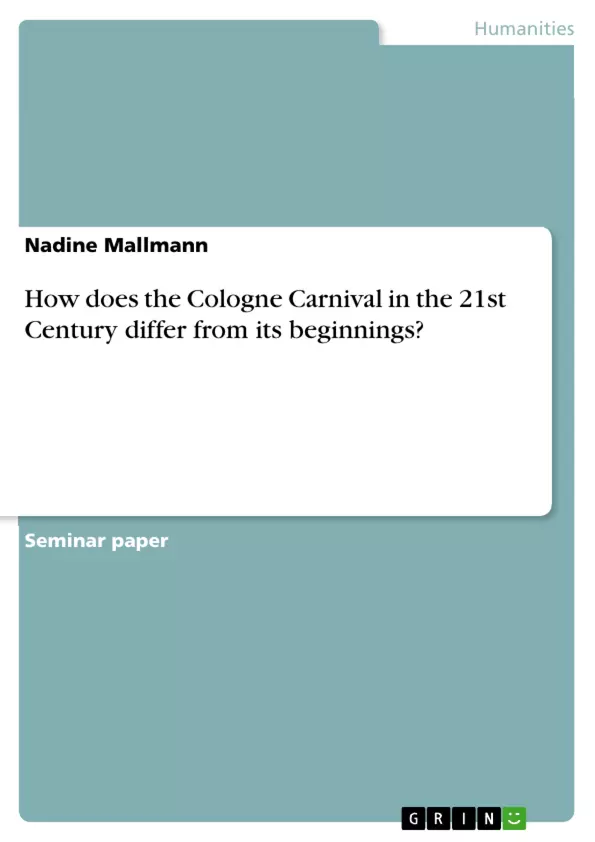"Kölle Alaaf" is the battle cry for the kickoff to the Cologne Carnival session. In the year 1733, Kölle Alaaf first appears as praise and drinking phrase. It means 'just Cologne'.
In this essay, I will have a deeper look at the relation between the historical Cologne Carnival in its beginnings and the modern Carnival in 2010. For this, I will talk about the Carnival Session itself to demonstrate what the story is behind the six days of Carnival. The Thursday is no usual weekday anymore, but the start of a week in which Cologne is in an exceptional state. Furthermore, I would like to focus on the question of the roots of the Cologne Carnival and the misinterpretation thereof and how this is still common today. To compare the beginnings of the Cologne Carnival with the one today, one needs a historical point of view. Insofar, I have studied the history of the Cologne Carnival and examined the most significant events. My main attention lies with the human interaction and behavior, the exercised customs and the further development of the tradition of Cologne. At the end of my essay, I will show the main characters of the Cologne Carnival.
This essay should answer the question of what the Cologne Carnival means today. The focus is on my main question “How does the Cologne Carnival in the 21st Century differ from its beginnings?” This essay leads you through the history of the Cologne Carnival and how its forms developed. The conclusion will give you an overview over my worked out insights.
Inhaltsverzeichnis (Table of Contents)
- I. Introduction
- II. Basics to understand the Cologne Carnival
- 2.1 Meaning of the “six rompy days” and its end
- 2.2 Explanation of the origin
- III. The Cologne Carnival and its development
- 3.1 The start of the Cologne Carnival in the 14th and 15th Century
- 3.2 Continuation of the Cologne Carnival in the 16th and 17th Century
- 3.3 Establishment of the Cologne Carnival in the 18th and 19th Century
- 3.4 The Cologne Carnival in the 20th and 21th Century
- IV. Important figures in the Cologne Carnival
- 4.1 The triumvirate
- 4.2 The fool
- V. Conclusion
Zielsetzung und Themenschwerpunkte (Objectives and Key Themes)
This essay delves into the evolution of the Cologne Carnival, comparing its historical beginnings to its modern practices in 2010. The aim is to understand the significance of the six-day celebration and explore the historical roots of the Cologne Carnival. The essay also addresses common misinterpretations about the Carnival's origin and its contemporary relevance.
- The historical development of the Cologne Carnival from its origins to the 21st century
- The significance of the six days of Carnival and their associated customs and rituals
- The roots of the Cologne Carnival and how they are misunderstood in modern times
- The role of important figures and symbols in the Cologne Carnival tradition
- The cultural impact and significance of the Cologne Carnival in contemporary society
Zusammenfassung der Kapitel (Chapter Summaries)
The Introduction provides a brief overview of the essay's focus, highlighting the historical context and contemporary significance of the Cologne Carnival. It emphasizes the importance of understanding the tradition's evolution and its cultural impact.
Chapter II delves into the foundational understanding of the Cologne Carnival. It explores the meaning behind the six days of Carnival, its traditional customs, and the historical significance of these practices. This chapter offers a comprehensive overview of the core elements that define the Cologne Carnival.
Chapter III examines the evolution of the Cologne Carnival throughout history. It outlines the significant events and changes that shaped the tradition, spanning from its inception in the 14th and 15th centuries to its modern manifestations in the 20th and 21st centuries. This chapter provides a detailed timeline of the Cologne Carnival's development.
Chapter IV highlights the important figures and roles within the Cologne Carnival tradition. It introduces key individuals and their contributions to the Carnival's cultural landscape. This chapter provides valuable insights into the personalities and symbols that embody the spirit of the Cologne Carnival.
Schlüsselwörter (Keywords)
Cologne Carnival, Carnival Session, Weiberfastnacht, Carnival Thursday, Cologne dialect, tradition, history, evolution, customs, rituals, figures, symbols, cultural impact, contemporary society.
- Quote paper
- B.A. Nadine Mallmann (Author), 2010, How does the Cologne Carnival in the 21st Century differ from its beginnings?, Munich, GRIN Verlag, https://www.grin.com/document/364775



